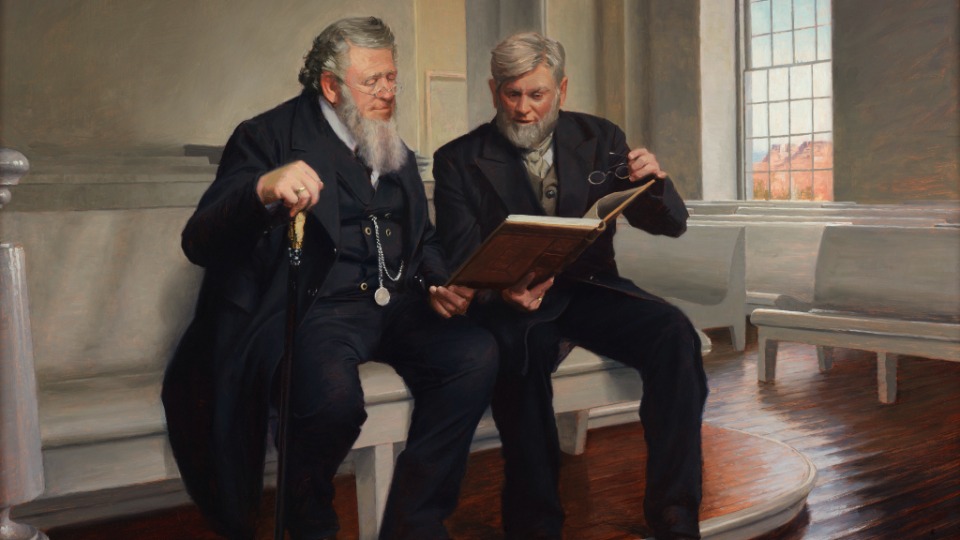The Salt Lake Temple, located in the heart of downtown Salt Lake City, took one step closer to resuming its sacred, central purpose as a place to make promises with God and unite families for eternity.
During a small gathering on Temple Square on the morning of Tuesday, April 2, 2024, the angel Moroni statue was returned to the top of the central east spire of the Salt Lake Temple. This house of the Lord has been undergoing a major seismic and foundational upgrade since the beginning of 2020.
-
- LES00616.JPG
- LES00181.JPG
- DJI_20240402_105117_503.jpg
- LES00497.JPG
- LES00395.JPG
- 20240401_073047_CPowell_CEP_7218.jpg
- 20240401_071955_CPowell_CEP_7080.jpg
- 20240402_104508_CPowell_15535.jpg
- HMW_3979.jpeg
- 20240402_102614_CPowell_15210.jpg
- 20240401_073819_CPowell_CEP_7337.jpg
- 20240402_104446_CPowell_15507.jpg
| Temple Square is always beautiful in the springtime. Gardeners work to prepare the ground for General Conference. © 2012 Intellectual Reserve, Inc. All rights reserved. | 1 / 2 |
The placement of the statue after a four-year absence (it was removed in May 2020) is a notable milestone toward the completion of the Salt Lake Temple renovation project. “An important part of this project has been to strengthen the foundation of the temple,” said Presiding Bishop Gérald Caussé. “President Russell M. Nelson spoke to the world about the need to fortify our spiritual foundations in 2021 when he reminded us of the sacred use of the house of the Lord and said, ‘The temple lies at the center of strengthening our faith and spiritual fortitude because the Savior and His doctrine are the very heart of the temple. Everything taught in the temple, through instruction and through the Spirit, increases our understanding of Jesus Christ.’”
Inside each of the Church’s many temples, faithful Latter-day Saints participate in sacred ceremonies. One of those ceremonies, the endowment, provides instruction, covenants and promised blessings that offer power, purpose and protection in daily life. Brigham Young and Wilford Woodruff (the second and fourth Presidents of the Church, respectively) were instrumental in fulfilling Joseph Smith’s direction to record and formalize the temple endowment ceremony.
This made it possible for more of God’s children to receive the saving and exalting ordinances provided only inside a temple.
President Young was instructed by Joseph Smith to “organize and systematize” temple ceremonies after they were first introduced in Nauvoo, Illinois. President Young also played an important role in supervising the original design and construction of the Salt Lake Temple. President Woodruff oversaw the completion of the construction and conducted the first dedication of the temple on April 6, 1893, 131 years ago.
Also present to witness the return of the statue were two people with family connections to the Salt Lake Temple — Elder Larry Y. Wilson and Mark Woodruff — descendants of Presidents Young and Woodruff, respectively.
“As Brigham Young focused the Latter-day Saints on the meaning and purpose of the temple, he worked with fellow Church leaders to organize the work,” said Elder Wilson, an emeritus General Authority Seventy. “He called Wilford Woodruff to be the first temple president in the Church. Together they organized the work of temple covenants in St. George, Utah. Brigham Young’s action in following Joseph Smith’s instruction to organize the temple ceremonies is an example of how revelation so often works. It’s line upon line and precept upon precept — a continually unfolding process. After Brigham Young’s death, Wilford Woodruff continued the charge from Joseph Smith.”

Mark Woodruff, Executive Secretary to President Nelson, said President Woodruff did all he could to continue the vision of Joseph Smith and Brigham Young.
“While President Woodruff knew the work would continue to be perfected over time, he also knew that families are central to God’s plan for His children and needed to be connected for eternity through sealing ordinances that take place in the temple,” Mark Woodruff said.
Mark Woodruff concluded with this teaching from his ancestor: “The glory of the whole matter is, that when we get through, we are going to have our families with us … in the morning of the Resurrection, in the family organization of the celestial world, to dwell forever and forever.”
Also present for the occasion was Emily Utt, a historic sites curator for the Church. She recalled the experience that Cyrus Dallin — accomplished sculptor who created the statue — had when sculpting the angel Moroni in the early 1890s. Dallin said the process “brought me nearer to God than anything I ever did. It seemed to me that I came to know what it means to commune with angels from heaven.”
“Though not a member of the Church, Dallin recognized that God speaks to his children,” Utt said. “His angel atop the temple reminds us that the heavens are open, and we can return to Him.”